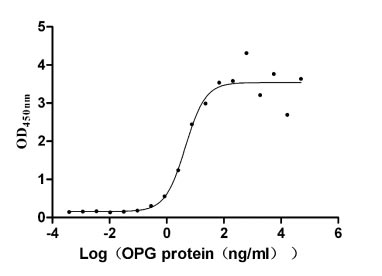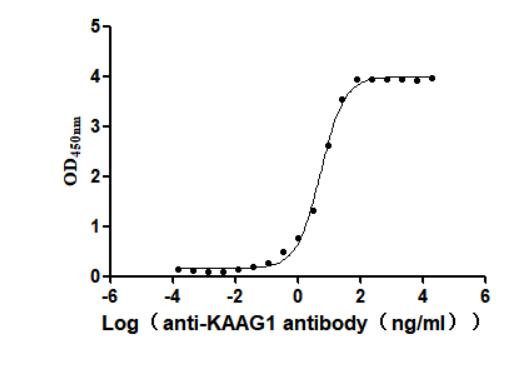Recombinant Rotavirus A Outer capsid glycoprotein VP7
-
中文名称:Recombinant Rotavirus A Outer capsid glycoprotein VP7,Yeast
-
货号:CSB-YP387201RIT
-
规格:
-
来源:Yeast
-
其他:
-
中文名称:Recombinant Rotavirus A Outer capsid glycoprotein VP7,Yeast
-
货号:CSB-EP387201RIT
-
规格:
-
来源:E.coli
-
其他:
-
中文名称:Recombinant Rotavirus A Outer capsid glycoprotein VP7,Yeast
-
货号:CSB-EP387201RIT-B
-
规格:
-
来源:E.coli
-
共轭:Avi-tag Biotinylated
E. coli biotin ligase (BirA) is highly specific in covalently attaching biotin to the 15 amino acid AviTag peptide. This recombinant protein was biotinylated in vivo by AviTag-BirA technology, which method is BriA catalyzes amide linkage between the biotin and the specific lysine of the AviTag.
-
其他:
-
中文名称:Recombinant Rotavirus A Outer capsid glycoprotein VP7,Yeast
-
货号:CSB-BP387201RIT
-
规格:
-
来源:Baculovirus
-
其他:
-
中文名称:Recombinant Rotavirus A Outer capsid glycoprotein VP7,Yeast
-
货号:CSB-MP387201RIT
-
规格:
-
来源:Mammalian cell
-
其他:
产品详情
-
纯度:>85% (SDS-PAGE)
-
基因名:N/A
-
Uniprot No.:
-
别名:Outer capsid glycoprotein VP7
-
种属:Rotavirus A (isolate Monkey/South Africa/SA11-H96/1958 G3-P5B[2]-I2-R2-C5-M5-A5-N5-T5-E2-H5) (RV-A) (Simian Agent 11 (isolate SI/South Africa/H96/58))
-
蛋白长度:full length protein
-
表达区域:51-326
-
氨基酸序列QNYGINLPIT GSMDTAYANS TQEETFLTST LCLYYPTEAA TEINDNSWKD TLSQLFLTKG WPTGSVYFKE YTNIASFSVD PQLYCDYNVV LMKYDATLQL DMSELADLIL NEWLCNPMDI TLYYYQQTDE ANKWISMGSS CTIKVCPLNT QTLGIGCLTT DATTFEEVAT AEKLVITDVV DGVNHKLDVT TATCTIRNCK KLGPRENVAV IQVGGSDILD ITADPTTAPQ TERMMRINWK KWWQVFYTVV DYVDQIIQVM SKRSRSLNSA AFYYRV
-
蛋白标签:Tag type will be determined during the manufacturing process.
The tag type will be determined during production process. If you have specified tag type, please tell us and we will develop the specified tag preferentially. -
产品提供形式:Lyophilized powder
Note: We will preferentially ship the format that we have in stock, however, if you have any special requirement for the format, please remark your requirement when placing the order, we will prepare according to your demand. -
复溶:We recommend that this vial be briefly centrifuged prior to opening to bring the contents to the bottom. Please reconstitute protein in deionized sterile water to a concentration of 0.1-1.0 mg/mL.We recommend to add 5-50% of glycerol (final concentration) and aliquot for long-term storage at -20℃/-80℃. Our default final concentration of glycerol is 50%. Customers could use it as reference.
-
储存条件:Store at -20°C/-80°C upon receipt, aliquoting is necessary for mutiple use. Avoid repeated freeze-thaw cycles.
-
保质期:The shelf life is related to many factors, storage state, buffer ingredients, storage temperature and the stability of the protein itself.
Generally, the shelf life of liquid form is 6 months at -20°C/-80°C. The shelf life of lyophilized form is 12 months at -20°C/-80°C. -
货期:Delivery time may differ from different purchasing way or location, please kindly consult your local distributors for specific delivery time.Note: All of our proteins are default shipped with normal blue ice packs, if you request to ship with dry ice, please communicate with us in advance and extra fees will be charged.
-
注意事项:Repeated freezing and thawing is not recommended. Store working aliquots at 4°C for up to one week.
-
Datasheet :Please contact us to get it.
靶点详情
-
功能:Calcium-binding protein that interacts with rotavirus cell receptors once the initial attachment by VP4 has been achieved. Rotavirus attachment and entry into the host cell probably involves multiple sequential contacts between the outer capsid proteins VP4 and VP7, and the cell receptors. Following entry into the host cell, low intracellular or intravesicular Ca(2+) concentration probably causes the calcium-stabilized VP7 trimers to dissociate from the virion. This step is probably necessary for the membrane-disrupting entry step and the release of VP4, which is locked onto the virion by VP7.
-
基因功能参考文献:
- These data suggest that the Indian wild-type rotavirus population is distinguishable based on the VP7 gene, and co-circulation of distinct strains in different hosts is foremost, indicating the possible likelihood of inter-species transmission. PMID: 25573161
- Compared antigenic epitopes of RVA strains circulating in Tunisia from 2006 to 2011 with the RVA strains present in licensed vaccines and found that multiple amino acid differences existed in or near putative neutralizing domains of VP7 and VP8. PMID: 23684631
- Rotavirus A strains isolated form Nepal all have amino acid substitutions D96N and S242N in VP7. PMID: 21842161
- T cells stimulated in vitro by the IA-2 epitope express IFN-gamma when restimulated by the similar rotavirus VP7 peptide. PMID: 20083660
- study reports the crystal structure at 3.4 angstrom resolution of VP7 bound with the Fab fragment of a neutralizing monoclonal antibody PMID: 19520960
显示更多
收起更多
-
亚细胞定位:Virion. Host endoplasmic reticulum lumen.
-
蛋白家族:Rotavirus VP7 family
-
数据库链接:
KEGG: vg:7011359
Most popular with customers
-
Recombinant Human Tumor necrosis factor receptor superfamily member 11B (TNFRSF11B) (Active)
Express system: Mammalian cell
Species: Homo sapiens (Human)
-
Recombinant Human Tumor necrosis factor ligand superfamily member 8 (TNFSF8), partial (Active)
Express system: Mammalian cell
Species: Homo sapiens (Human)
-
Recombinant Macaca fascicularis Membrane spanning 4-domains A1 (MS4A1)-VLPs (Active)
Express system: Mammalian cell
Species: Macaca fascicularis (Crab-eating macaque) (Cynomolgus monkey)
-
Recombinant Human CUB domain-containing protein 1 (CDCP1), partial (Active)
Express system: Mammalian cell
Species: Homo sapiens (Human)
-
Recombinant Human Transmembrane 4 L6 family member 1(TM4SF1)-VLPs (Active)
Express system: Mammalian cell
Species: Homo sapiens (Human)
-
Recombinant Human Gastric inhibitory polypeptide receptor(GIPR),partial (Active)
Express system: Mammalian cell
Species: Homo sapiens (Human)
-
Recombinant Human Kidney-associated antigen 1(KAAG1) (Active)
Express system: Baculovirus
Species: Homo sapiens (Human)
-
Recombinant Human C-C chemokine receptor type 5 (CCR5)-VLPs (Active)
Express system: Mammalian cell
Species: Homo sapiens (Human)




















